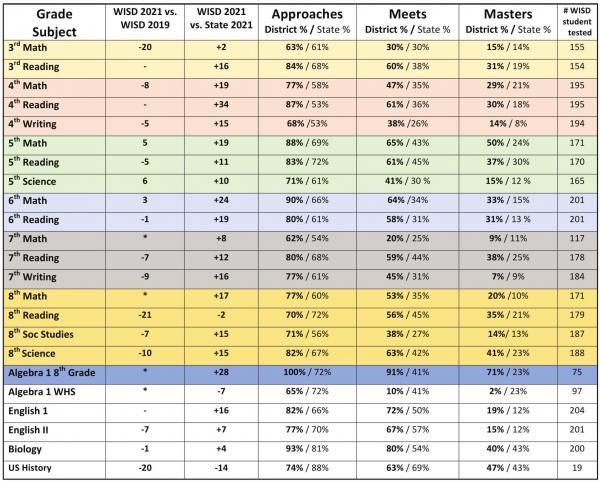WISD plans for rebound from pandemic STAAR scores
Wimberley ISD Administrators were blunt with their assessment of the recently released scores from the State of Texas Assessment of Academic Readiness, or STAAR, test. The scores, even though they were largely well above the state averages, were not up to WISD standards.
This was expected following an academic year that was marred by the COVID-19 pandemic. Scores across the state have fallen. In 31 categories tested by the state, 29 were lower in 2021 versus 2019, which was the last time the state tested. Most were down 10 percentage points or more. In contrast, WISD had smaller drops compared to their 2019 scores than the state. Outside of four categories, the areas WISD lost ground in were all by single digit drops in the 23 categories WISD was tested in. In five categories WISD was the same or better in 2021 versus 2019. (See a full graphic of all the STAAR numbers on page 8.)
“We weren’t going to change the standard or the level of progress expected throughout the year,” Wimberley ISD Superintendent Dwain York said. “We know where our kids need to be… I think we did one heck of a job driving our kids as close to that standard as possible.”
There are four standards measured by the STAAR test. The first is “Did Not Meet Grade Level.” The rest of the standards, “Approaches,” “Meets” and “Masters,” are varying de grees of passing grades.
For the large majority of grade levels and subjects, WISD was more than 10 percentage points above the state average for those at least approaching grade level skills, which is the lowest passing standard. That typical increase continued through the “Meets” and “Masters” standards.
“It hurts to see that we have some areas where we have strugglers, in particular when you are looking at reading and math,” Assistant Superintendent Dee Howard said. “It is hard to look at those numbers and see (only 70 or 80 percent of kids passing) in those areas, because our teachers work hard, and we feel like the kids could do better. However, in light of what we have been through as a district, and as a world, over the last 15 months, we know there are some learning gaps we will have to work on.”
A few of the highlights from the report are areas like fourth grade reading, which with 87% of students reaching the Approaches standard was 34 points above the state average. For students who are advanced enough in math to take Algebra in the eighth grade, 100 percent reached the Approaches standard.
WISD didn’t reach the state average in three of the 31 tested categories. In eighth grade reading, WISD had 70% of students reach the Approaches standard, which was two points below the state average. In Algebra I at Wimberley High School (which excludes those who took the course early in eighth grade), 65% of students meet the Approaches standard, which was seven points below state average. In US History WISD had 74% of students reach the Approaches standard that was 14 points below the state average. With only 19 students tested in US History, Howard called the low score in that category an “anomaly.” She stated that WISD traditionally has more than 90% reach the Approaches standard, which she expects will be the case moving forward.
Coming out of such a unique situation as posed by the COVID-19 pandemic, York said that WISD would not focus on the overall numbers but rather use the assessment to find the areas individual students need extra work.
“There were so many challenges,” York said. “I have been praising our teachers left and right. Our scores still far exceed the state, so I’m not even looking at those test scores. We’re going to take the test data, and forget the scores. We will use it to find out where the academic gap is, and start there. That is how we’ll get ourselves back on track.”
In fact, York said much of the work has already started. While these assessments will help, York said that the school district began the process of identifying the gaps from students as they individually came back from remote learning. It has now continued with a process called “vertical teaming,” which connects a student’s previous teacher with their upcoming teacher to discuss skill levels. The district has also heavily invested in summer school this year, which is not typically needed in Wimberley.
“I just want to thank the parents for taking it seriously,” York said. “We’ve worked around vacations. We’ve worked around all different types of summer activities. We really are making progress. Some of the achievement gaps that we saw before even taking the test are closing already, which is good.”
York said that the district starting in person schooling as early as possible helped significantly. Remote learning was not only difficult on teachers, but also meant that students returning to class later were at a different skill level than their in-person peers. Even with lower STAAR test results than typical, York marked the school year as a success given the difficulties presented.
“Teachers did a phenomenal job this year in unprecedented challenges,” York said. “The school district is so proud to say we started on August 19 of 2020, and we finished with graduation at the football stadium. We met the challenges. It’s just everybody working together, and I couldn’t be more proud.”


